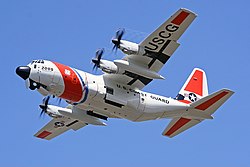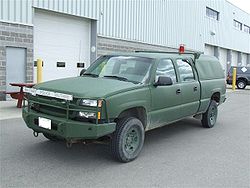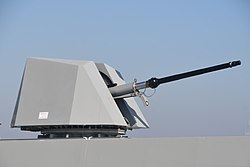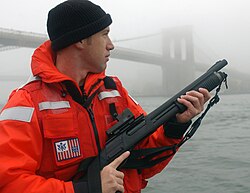

Originally, the Coast Guard used the term cutter in its traditional sense, as a type of small sailing ship. [1]
Larger cutters, over 181 feet (55 m) in length, are controlled by Area Commands, the Atlantic Area or Pacific Area. Smaller cutters come under control of district commands. Cutters usually carry a motor surf boat and/or a rigid-hulled inflatable boat. Polar-class icebreakers (WAGB) carry an Arctic survey boat (ASB) and landing craft.
Any Coast Guard crew with officers or petty officers assigned has law-enforcement authority (14 USC Sec. 89) and can conduct armed boardings.
The Coast Guard operates 243 Cutters, [2] defined as any vessel more than 65 feet (20 m) long, that has a permanently assigned crew and accommodations for the extended support of that crew. [3]
| Name or Class | Image | Quantity | Length | Armament | Notes |
|---|---|---|---|---|---|
| Polar-class 2 | 0 | 460' |
| Building 2, 3 total on order. The Polar Security Cutter Program is to replace the Polar-class. To enter service in 2025. | |
| Healy-class |  | 1 | 420' |
| Medium class icebreaker used for icebreaking and research. Entered service in 2000. [5] |
| Legend-class |  | 10 | 418' |
| 10 Active; Building 1; Option for 12th. [6] Designated to replace the Hamilton-class. Entered Service in 2008. |
| Polar-class |  | 1 | 399' |
| USCGC Polar Star (WAGB-10) is only active heavy icebreaker. Entered service in 1976. [7] [8] [9] USCGC Polar Sea (WAGB-11) is located in Seattle, Washington but is not currently in active service. |
| USCGC Storis | 1 | 360' | None | The only Anchor handling tug supply vessel icebreaker and recently acquired in 2024. [10] Planned to be in service in 2026 and will be homeported in Juneau, Alaska but is not currently in active service. | |
| Heritage-class |  | 0 | 360' |
| 3 under construction; 12 ordered or optioned; 25 total planned. [11] Designated to replace the Famous-class and Reliance-class. To enter service in 2025. [12] |
| USCGC Eagle |  | 1 | 295' | None | USCGC Eagle (WIX-327): Eagle is home ported at the Coast Guard Academy in New London, Connecticut. It is used for training voyages for Coast Guard Academy cadets and Coast Guard officer candidates. USCGC Eagle was built in Germany as the Horst Wessel , and was taken by the United States as a war reparation in 1945. |
| USCGC Alex Haley |  | 1 | 283' |
| Entered service in 1971 as USS Edenton. |
| Famous-class |  | 13 | 270' |
| Entered service in 1983. |
| USCGC Mackinaw |  | 1 | 240' |
| Mackinaw is a 240-foot (73 m) heavy icebreaker built for operations on the North American Great Lakes and home ported at Cheboygan, Michigan. Entered Service in 2006. |
| Juniper-class |  | 16 | 225' |
| Entered service in 1996. |
| Reliance-class |  | 14 | 210' |
| Entered service in 1964. |
| Keeper-class |  | 14 | 175' | None | Entered service in 1997. |
| 160-ft inland construction tender |  | 4 | 160' | None | Entered service in 1976. |
| Sentinel-class |  | 59 | 154' |
| 67 planned. Designated to replace Island-class. Entered service in 2012. |
| Bay-class |  | 9 | 140' | 10 planned. Entered service in 1979. | |
| Island-class |  | 49 | 110' | (WPB): Eight additional 110-foot patrol boats were extended to 123 feet (37 m) but structural issues developed shortly after these conversions and the cutters were deemed unsafe to operate. [13] Entered service in 1985. | |
| 100-ft inland buoy tender |  | 2 | 100' | None | Entered service in 1945. |
| 100-ft inland construction tender |  | 3 | 100' | None | Entered service in 1944. |
| Marine Protector-class |  | 67 | 87' |
| Entered service in 1998. Sea PROTECTOR MK50 GWS Carried on four Marine Protector Class Cutters. |
| Kankakee-class |  | 2 | 75' | None | Entered service in 1990. |
| Gasconade-class |  | 9 | 75' |
| Entered Service in 1964 |
| 75-ft inland construction tender |  | 9 | 75' | None | Entered service in 1962 |
| 65-ft river buoy tender |  | 2 | 65' | None | |
| 65-ft inland buoy tender |  | 2 | 65' | None | Entered service in 1954 |
| 65-ft small harbor tug |  | 11 | 65' | None | (WYTL): This is a class of eleven 65-foot tugs used by the United States Coast Guard for search and rescue, law enforcement, aids-to-navigation work and light icebreaking. Entered service in 1961. |
The Coast Guard operates about 1,402 boats, defined as any vessel less than 65 feet (20 meters) in length, which generally operate near shore and on inland waterways. The most common is 25 feet (7.6 m) long, of which the Guard has more than 350. [14] The shortest is 13 feet (4.0 m).
| Name | Image | Length | Notes |
|---|---|---|---|
| 65-ft Aids to Navigation Boat |  | 64' | |
| 64-ft Screening Vessel |  | 64' | |
| 55-ft Aids to Navigation Boat |  | 55' | |
| 52-ft Motor Lifeboat |  | 52' | The Coast Guard currently has four of the 52-foot motor life boats, a craft designed from the ground up to serve in challenging surf conditions. All four craft are currently assigned to surf stations in the Pacific Northwest. Also known as "Special Purpose Craft - Heavy Weather (SPC-HWX)" |
| 49-ft Buoy Utility Stern Loading |  | 49' | |
| 47-ft Motor Lifeboat |  | 47' | The Coast Guard's 47-foot primary heavy-weather boat used for search and rescue as well as law enforcement and homeland security. [15] |
| Response Boat – Medium |  | 45' | The Coast Guard has signed a multi-year contract for 180 Response Boat – Medium (RB-M) boats that were delivered starting in 2008 to replace the 41′ UTB boats. These aluminum boats are 45 feet (14 m) in length, with twin diesel engines (total 825 hp), are self-righting, have a four crew, six passenger capacity, are equippable with two .50 caliber machine guns, have an excellent fendering system, can achieve a top speed of 42 knots (78 km/h), and are capable of towing a 100-ton vessel in eight-foot seas. The boats were built by Kvichak Marine Industries of Kent, Washington and Marinette Marine of Manitowoc, Wisconsin. [16] [17] |
| Near-Shore Life Boat | 42' | ||
| 39-ft Tactical Training Boat | 39' | ||
| 38-ft Training Boat | 38' | ||
| Arctic Survey Boat |  | 38' | Only one of these vessels is used by the Coast Guard. It is kept on the USCGC Healy and is used for arctic studies. |
| 36-ft Boarding Team Delivery | 36' | ||
| Long-Range Interceptor |  | 36' | An 11-meter (36-foot) high-speed launch that can be launched from the rear ramps of the National Security Cutters. [18] |
| 33-ft Law Enforcement |  | 33' | |
| 26-ft Trailerable Aids to Navigation Boat | 29' | ||
| Response boat – Small II |  | 29' | A 29-foot replacement for the Defender Class, built by Metal Shark Boats. |
| Cutter Boat – Over the Horizon |  | 25' | |
| Transportable port security boat |  | 25' | 25-foot (7.6 m) boat, based on the commercial version of the 25-foot (8 m) center-console Boston Whaler, suitable for work in inland waters, easily transportable by trailer. These are primarily used by Port Security Units for force protection in naval support areas abroad, as well as, ports of embarkation/debarkation in expeditionary areas. Most recently these boats and units were deployed to Kuwait in support of Operation Iraqi Freedom. The durability, versatility, and mobility of these boats make them ideal for this type of operation. [19] |
| Response boat – Small |  | 25' | A high-speed boat, for a variety of missions, including search and rescue, port security and law enforcement duties. The original 25-foot boats built by SAFE Boats International (Secure All-around Flotation Equipped) of Port Orchard, Washington are being replaced by 29-foot boats built by Metal Shark Boats of Jeanerette, LA. [20] [21] |
| 24-ft Shallow Water |  | 24' | |
| 24-ft Cutter Boat – Aids to Navigation – Large | 23' | ||
| Cutter Boat – Over the Horizon | 24'-19' | ||
| 22-ft Airboat |  | 22' | |
| 20-ft Aids to Navigation Boat – Small |  | 21' | |
| 20-ft Airboat | 20' | ||
| 18-ft Cutter Boat – Aids to Navigation – Medium | 18' | ||
| 18-ft Airboat | 18' | ||
| Cutter Boat – Medium | 17' | ||
| 16-ft Aids to Navigation Boat – Skiff | 16' | ||
| Cutter Boat – Small | 13' |

The Coast Guard operates about 210 aircraft. Fixed-wing aircraft, such as Lockheed HC-130 Hercules turboprops, operate from Air Stations on long-duration missions. Helicopters (Aérospatiale HH-65 Dolphin and Sikorsky HH-60J Jayhawk) operate from Air Stations, Air Facilities, and flight-deck equipped cutters, and can rescue people or intercept smuggling vessels. Some special MH- designated helicopters are armed with guns and some are equipped with armor to protect against small arms fire.
| Name | Image | Quantity | Notes |
|---|---|---|---|
| HC-130J Hercules |  | 27 | |
| HC-27J Spartan |  | 11 | [22] [23] Out of 14 on order. |
| HC-144 Ocean Sentry |  | 18 | [24] [25] [26] |
| C-37 |  | 2 | Aircraft as a VIP transport for high-ranking Coast Guard and Homeland Security officials. [27] |
| MH-65 Dolphin |  | 102 | To be retired. |
| MH-60T Jayhawk |  | 42 | Fleet to expand to 127 aircraft to replace Dolphin. [28] |
| RG-8A Condor |  | unspecified number | |
| Boeing Insitu ScanEagle |  | unspecified number | [29] |
The Coast Guard was to purchase the Bell Eagle Eye UAV as part of the Deepwater program, but this has been cancelled. [30] The Coast Guard is currently preparing to launch a small UAS competition for the Legend-class NSC and future Heritage-class cutter. [31]
In addition to regular Coast Guard aircraft, privately owned general aviation aircraft are used by Coast Guard Auxiliarists for patrols and search-and-rescue missions.
| Name | Image | Origin | Notes |
|---|---|---|---|
| HMMWV |  | Used primarily by Deployable Specialized Forces [32] | |
| LSSV |  | [33] |
| Name | Image | Notes |
|---|---|---|
| M153 CROWS II |  | Sea PROTECTOR MK50 GWS |
| Mk 38 25mm autocannon |  | Mod 1, Mod 2 and Mod 3 |
| Mk 44 30mm autocannon |  | |
| Phalanx CIWS |  | 20 mm Block 1B Baseline 2 |
| Bofors 57 mm gun |  | MK 110. A variant of the Bofors 57 mm gun and Gunfire Control System |
| OTO Melara Mark 75 |  | 76 mm/62 caliber naval gun |
| Name | Image | Notes |
|---|---|---|
| Mark 36 SRBOC |  | chaff countermeasures |
| Nulka |  | MK 53 Mod 10 |
| Model | Image | Caliber | Type | Origin | Details |
|---|---|---|---|---|---|
| P229R-DAK |  | .40 S&W | Pistol | Former service pistol | |
| Glock 19 |  | 9mm | Pistol | Standard service pistol. Replacing the Sig P229R-DAK [34] | |
| Colt M1911 Gold Medal Match |  | .45 ACP | Pistol | United States | Utilized exclusively for Excellence in Competition (EIC) |
| M16A2 | | 5.56×45mm NATO | Assault rifle | Limited service | |
| M4 |  | 5.56×45mm NATO | Assault rifle, Carbine | Standard issue service rifle. The Deployable Operations Group also employs the Mk 18 upper receiver [35] | |
| MK18/CQBR |  | 5.56×45mm NATO | Assault rifle, Carbine | Standard issue service carbine. The Deployable Specialized Forces also employs them | |
| M870P |  | 12-gauge | Shotgun | ||
| Saiga-12 | 12-gauge | Shotgun | The Deployable Specialized Forces employs them | ||
| M240 |  | 7.62×51mm NATO | General purpose, medium machine gun | M240B variant is employed aboard surface vessels while the M240H is used aboard the MH-60 Jayhawk and MH-65 Dolphin helicopters. The M240 is also used on land by Port Security Units [36] | |
| M249 |  | 5.56×45mm NATO | Light machine gun | Used on various boats and primarily by Deployable Specialized Forces | |
| M60 |  | 7.62×51mm NATO | General purpose, medium machine gun | Used on various boats such as the Defender-class boat [37] | |
| Browning M2HB |  | .50 BMG | Heavy machine gun | Primarily mounted on seagoing vessels. Some machine guns are used on land by Port Security Units [38] | |
| MK14 EBR |  | 7.62×51mm NATO | Designated marksman rifle, Sniper rifle | Variant known as the M14 Tactical fitted with the Mk 14 Enhanced Battle Rifle stock, with a 22-inch barrel and a Smith Enterprise muzzle brake. | |
| Mk 11 |  | 7.62×51mm NATO | Designated marksman rifle, Sniper rifle | Used by the Deployable Specialized Forces [35] | |
| Barrett 50 cal/M82/M107 |  | .50 BMG | Anti materiel sniper rifle | Used for Airborne Use of Force (AUF) missions | |
| Robar RC-50 | .50 BMG | Anti materiel sniper rifle | |||
| M203 |  | 40mm | Grenade launcher | Single-shot underbarrel grenade launcher [39] | |
| Mk 19 |  | 40mm | Automatic grenade launcher | Belt-fed | |
| MK3 grenade |  | Concussion Grenade | Used as an anti-swimmer grenade. Being phased out and being replaced by a newer Anti-Swimmer Grenade. [40] |
Coast Guard radio stations cover a wide geographical area using very high frequency and high frequency radios. There are eight major radio stations covering long-range transmissions and an extensive network of VHF radio stations along the nation's coastline and inland rivers.
The current communication system is the Rescue 21. Rescue 21 is an advanced maritime command, control, and communications (C3) system.
The OMEGA navigation system and the LORAN-C transmitters outside the USA were run until 1994 also by the United States Coast Guard, and LORAN-C transmitters within the US were decommissioned in June 2010, with the exception of 5 CONUS LORAN-C stations that continue to be staffed due to international agreements.
{{cite web}}: CS1 maint: bot: original URL status unknown (link){{cite web}}: CS1 maint: bot: original URL status unknown (link)